 Anonymous, c1400, "Le jeu de la hache" - Escrime Ancienne Anonymous, c1400, "Le jeu de la hache" - Escrime Ancienne |
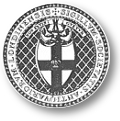 |

 |
Bibliothéque Nationale France MS FR. 1996 - Plus ancien traité de combat français, ce manuscript Bourguignon traite du combat à la hache d'arme. "Axe-play" A French (Bourguignon) combat manuscript (in French) describes the techniques, form and function of combat with the battle-axe. See Dr. Anglo's interpretation of this treatise in the 20c section of this library.
- released August 10, 2001- Click on the AEMMA arms to view Dr. Sydney Anglo, 1991, "Le Jeu de la Hache" - Archaeologia - (Society of Antiquaries of London)
( internal access only )
|
|
  Fiore dei Liberi, 1409, "Flos Duellatorum" Francesco Novati, Bergamo, 1902, Pisani-Dossi Collection Fiore dei Liberi, 1409, "Flos Duellatorum" Francesco Novati, Bergamo, 1902, Pisani-Dossi Collection |
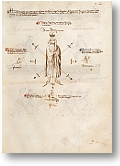 |
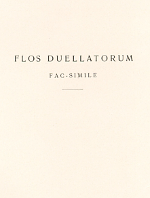
Pisani-Dossi

 |
| Francesco Novati, Flos duellatorum: Il Fior di battaglia di maestro Fiore dei Liberi da Premariacco (Bergamo, 1902), Pisani-Dossi Collection. - Fiore dei Liberi's 'Flos Duellatorum, or 'Flower of Battle' is an Italian treatise, which was started on Februrary 10, 1409 and completed in six months in late 1409 (1410 using the modern calendar). It is primarily composed of illustrations accompanied with short rhyming captions in a Venetian dialect of Italian. Some details of Fiore dei Liberi can be found in its prologues, one in Italian and the second in Latin. The prologue also explains the structure and conventions found in the treatise. Fighting styles covering wrestling, dagger, sword, spear, longsword, armoured combat, pollaxe, and mounted combat are included in the treatise with considerable discussion of disarming techniques in particular, in the dagger and sword sections.
This resource is freely available to any and all AEMMA students, as well as to the public in general. The structure of this resource is designed to provide learning assistance, in particular to recruits who are planning to challenge for the rank of scholler.
- released October 20, 1999, updated December 12, 2008 |
|
 Anonymous, 1425-1475, "Gladiatoria" - Biblioteka Jagiellonski Anonymous, 1425-1475, "Gladiatoria" - Biblioteka Jagiellonski |
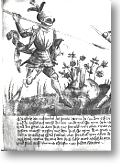 |
|
Biblioteka Jagiellonski, Krakow - Ms. Germ. Quart. 16, NR: 5878 1989 ROK - "Gladiatoria" is an obscure fechtbüch recently "uncovered" and resurrected by Grzegorz Zabinski (in association with the Brotherhood of the Eagle's Nest, Poland - no longer active) from the archives of the Biblioteka Jagiellonski, Poland, originally part of the collection of "Die Preussische Koenigliche Staatsbibliothek" in Berlin, is thought to have been written sometime c1450. It is unfortunate that very little is known about this manuscript, including the name of the author. This German manuscript contains beautifully detailed illustrations of a pair of fighters, in full plate harness, depicting various types of engagements, including half-sword, dagger and spear.
- released November 19, 2000
 | <== click icon to log into the library to access the manuscript
entitled Gladiatoria |
|
|
 Sigmund Ringeck, c1440, "Die Ritterlich Kunst des Langen Schwerts" - Sächsische Landesbibliothek Sigmund Ringeck, c1440, "Die Ritterlich Kunst des Langen Schwerts" - Sächsische Landesbibliothek |
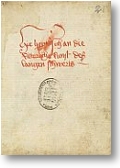 |

 |
Mscr.Dresd.C487 / Dresden, Sächsische Landesbibliothek - A presentation of the complete German manuscript as written by Sigmund Ringeck containing an invaluable resource of commentaries on die ritterlich kunst des langen schwerts or the "knightly art of the longsword", an example section included in the manuscript describing concepts originally created by Johannes Liechtenauer, scripted by Hanko Döbringer, c1389.
- released October 10, 2001, updated October 26, 2009
 | <== click icon to log into the library to access the manuscript by
Sigmund Ringeck |
|
|
 Anonymous, c1440, "Untitled" - Österreichische Nationalbibliothek, Vienna Anonymous, c1440, "Untitled" - Österreichische Nationalbibliothek, Vienna |
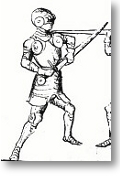 |
|
Codex Vindobonensis B 11093 - According to Dr. Hans Peter-Hils, this fechtbüch appears to have originated in southwestern Germany, the clothing, arms and weapons point to the middle of the 15th century. The manuscripts configuration, scope and contents evoke associations to the "Gladiatoria" - group (this is a catch all group whose major cause for association is that it does not directly fall into the Liechtenauers school, although they do exhibit many of the characteristics, but not all. The manuscript contains only illustrations in 46 pages, and cover fighting arts disciplines that include armoured fighting with spears, armoured longsword on foot, armoured longsword and dagger, pollaxe, wrestling and swordfighting on horseback.
- released February 21, 2002
 | <== click icon to log into the library to access the manuscript
referred to as the Codex Vindobonensis |
|
|
 Peter von Danzig, 1452, "untitled" Bibliotheca dell'Academica Nazionale dei Lincei e Corsiniana Peter von Danzig, 1452, "untitled" Bibliotheca dell'Academica Nazionale dei Lincei e Corsiniana |
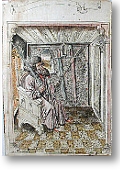 |

 |
Cod.44 A 8 (Cod. 1449) 1452 / Bibliotheca dell'Academica Nazionale dei Lincei e Corsiniana - von Danzig's fechtbüch contains comments on the cryptic verses of Liechtenauer and other German masters covering the use of the sword-and-buckler, dagger, longsword and grappling. The manual contains 114 leaves of text in which all but 2 leaves contain illustrations.
- released November 29, 2001- Click on the AEMMA arms to view Peter von Danzig's untitled treatise ( internal access only )
- Click on the "griffen" arms to view some English translations in progress of Danzig's fechtbüch.
|
|
 Hans Talhoffer, 1455/58, "Der Königsegger Codex : die Fechthandschrift des Hauses Königsegg" Hans Talhoffer, 1455/58, "Der Königsegger Codex : die Fechthandschrift des Hauses Königsegg" |
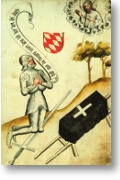 |
 |
| Hesburgh Library General Collection GV 1145 .T35 2010 v.1 and v.2 - a pictoral presentation of fencing training of Junker (squire) Lutold III (aka Liutold or Leutold) von Königsegg (ca. 1446-1473) who is believed to have commissioned the manuscript. It includes 114 pen drawings in water colour depicting single combat using various weapons or unarmed, with sequences on horseback, armour, grappling. Manuscript was first discovered in the county of southeastern Baden-Wurttemberg (Germany). Dimensions: 73 paper folios - 310 x 230 mm. The manuscript written in German (schwaebisch) , Middle High German.
- released April 04, 2012 - Click on the AEMMA arms to view Der Königsegger Codex ( internal access only )
|
|
 Hans Talhoffer, 1459, "Alte Armatur und Ringkunst" - The Royal Library, Copenhagen Hans Talhoffer, 1459, "Alte Armatur und Ringkunst" - The Royal Library, Copenhagen |
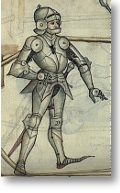 |
 |
| Det Kongelige Bibliotek, Copenhagen, Thott 290 2º, 150 ff. Bayern 1459 - Talhoffer's "Alte Armatur und Ringkunst" or roughly translated: "Old Armament and Art of Fight" was published in Bavaria 1459 by Hans Talhoffer, scripted by Michael Rotwyler and in which Hans Talhoffer himself posed for the illustrations. The work covers a variety aspects of war, including war machines and devices, illustrations with short descriptions for the two-handed sword, sword and buckler, sword and shield, dagger, wrestling, pollaxe, judicial combat, and mounted combat. As well as some specialized forms for the judicial duel: double-ended dueling pavises used with sword or club, and man in a pit with a club, and a woman with a rock in a sock. The presentation of this manuscript is through integrating the complete online presentation of the treatise provided by Det Kongelige Bibliotek, Copenhagen. Further descriptions and background on the various sections are included in this AEMMA presentation, not found in the Det Kongelige Bibliotek's online presentation.
- released March 8, 2000 |
|
 Schwabenspiegel. Chroniken von Zürich und Toggenburg, c1462, "Fechtbüch" - UB München Schwabenspiegel. Chroniken von Zürich und Toggenburg, c1462, "Fechtbüch" - UB München |
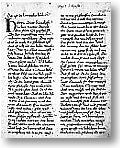 |
 |
BSB Cgm 558, Münchener Digitalisierungszentrum - Fechtbüch, c1462 is comprised of 330 folios, devoid of any illustrations, similar in the hand writing style of von Danzig's treatise. The manuscript is divided into sections, each section preceded by a blank page, and in a number of folios, there are annotations written in the margins.
- released Sep 5, 2009- Click on the BSB logo to view an online presentation of the manuscript on the Münchener Digitalisierungszentrum website.
|
|
  Hans Talhoffer, 1467, "fechtbüch aus dem Jahre 1467" - PDF file (2.5MB) courtesy of AEMMA Hans Talhoffer, 1467, "fechtbüch aus dem Jahre 1467" - PDF file (2.5MB) courtesy of AEMMA |
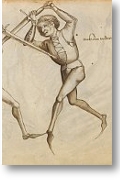 |


 |
Hergsell, Gustav: Hans Talhoffer's "fechtbüch aus dem Jahre 1467", Prague, 1887 - Talhoffer's original 'fechtbüch aus dem Jahre 1467' or 'Fencing Book of the Year 1467' was translated into French and re-published in Prague 1887 by Gustav Hergsell. A secondary source includes a publication of Talhoffer's "fechtbüch aus dem Jahre 1467" or 'Fencing Book of the Year 1467' by VS Books, 1998, Herne (Germany). The 1998 publication is a reprint of Hergsell's work except for the incorporation the plates or "tafels" with a modern German translation of the text. The work is a catalog of fencing actions and consists of illustrations with short descriptions for the two-handed sword, sword and buckler, sword and shield, dagger, wrestling, pollaxe, judicial combat, and mounted combat. As well as some specialized forms for the judicial duel: double-ended dueling pavises used with sword or club, and man in a pit with a club, woman with a rock in a sock.
- released November 9, 1998
 | <== click icon to log into the library to access the manuscript
entitled Fechtbüch aus dem Jahre 1467 |
 | Fechtbuch von 1467 - BSB Cod.icon. 394 a, an online presentation of the original manuscript available at Bayerische Staatsbibliothek by clicking on the BSB logo on the left. |
|
|
 von Baumans, c1470, "Fechtbüch" - Universitätsbibliothek Augsburg von Baumans, c1470, "Fechtbüch" - Universitätsbibliothek Augsburg |
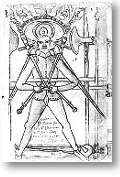 |
 |
Universitätsbibliothek Augsburg: Cod.I.6.40.2 - A most interesting manuscript also known as the Codex Wallerstein, comprised of at least two fechtbücher, one that may be dated c1380, and the second fechtbüch dated sometime in the later half of the 15th century. It's history being somewhat complex, it may have been in the collection of Michael Bauman, and bears the inscription von Baumans 1548. Subsequently it was collected by Paulus Hector Mair and it bears his signature and commentary. The fechtbüch may have initially been created sometime around 1470 (about the time Dürer was born). Albrecht Dürer (1471-1528) served as the artistic editor and translator. The relevant portions of the original fechtbüch had its sequences re-structured, updated and transposed the original Bavarian dialect to German by Friedrich Dörnhöffer's re-issue in 1910. The present fechtbüch or Codex Wallerstein is written in German and contains extraordinary images, many depicting fully armoured individuals engaged using longsword, spear and pollaxe weapons.
- released December 22, 2000
 | <== click icon to log into the library to access the manuscript
referred to as the Codex Wallerstein |
|
|
 Unknown, c1470, "Das Solothurner Fechtbüch" - Zentralbibliothek Solothurn Unknown, c1470, "Das Solothurner Fechtbüch" - Zentralbibliothek Solothurn |
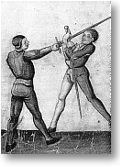 |
|
| Zentralbibliothek Solothurn: Cod. S554 - The original Solothurn publication of 'Das Solothurner fechtbüch' is thought to be written sometime in the late 15th century. This may be supported with an inference to Paulus Kal which could date the manuscript no earlier than c1470. It has recently been re-compiled and published by Zentralbibliothek (Central Library), Solothurn, Switzerland in 1989 by a Swiss gentleman by the name of Dr. Charles Studer. The re-compiled manuscript was prepared from the surviving 30 plates of the original 60 which contains 57 illustrations of the original 120 that illustrate a number of techniques such as armoured longsword, mounted fighting, dagger, grappling (ringen) and shield work which appear strikingly similar to those illustrations found in Talhoffer's works. Studer's publication focus was on the cultural and legal context of the judicial combat engagements depicted in the original manuscript. Dr. Studer, neither a swordsman nor fencer did not possess the authourity on historical European martial arts and therefore his interpretative comments are suspect. |
|
 Paulus Kal, c1479, "untitled (Kunst des Fechtens)" - Bayerische Staatsbibliothek Paulus Kal, c1479, "untitled (Kunst des Fechtens)" - Bayerische Staatsbibliothek |
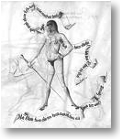 |
 |
Bayerische Staatsbibliothek: Cgm 1507, [S.l.] Bayern 2. Hälfte 15. Jh. - Paulus Kal was employed by a Bavarian Duke and given the timing of the manuscript, was a rival of Hans Talhoffer. They both produced a "fechbücher" following the Liechtenauer tradition. The 200 page manuscript is beautifully illustrated covering fencing on horseback, and the usual collection of styles on foot. The images of the manuscript are hosted on the Bayerische Staatsbibliothek website.
- released June 26, 2006 |
|
 Johannes Lecküchner, 1482, "Kunst des Messerfechtens" - München, Bayerische Staatsbibliothek Johannes Lecküchner, 1482, "Kunst des Messerfechtens" - München, Bayerische Staatsbibliothek |
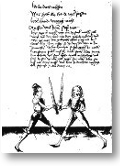 |

 |
Cod. Pal. Germ. 430 (Heidelberg, 1478), and Cgm. 582, Munich, 1482 - Johannes Lecküchner (ca. 1430s–1482) was a 15th century priest and fencer of the area of Nuremberg. The Cgm 582 manuscript on 216 folia (432 pages) gives instructions for the fencing with the großes messer, illustrated by 415 drawings of fencers. Lecküchner's system is based on the teachings of Liechtenauer dating to about a century earlier, since Lecküchner organized his system in the same way as Liechtenauer, and also uses the same terminology that is present in Liechtenauer's longsword teachings.
- released July 18, 2009
 | <== click icon to log into the library to access the manuscript by
Johannes Lecküchner |
|
|
 Fillipo Vadi, 1485, "De Arte Gladiatoria Dimicandi" - Biblioteca Nazionale di Roma Fillipo Vadi, 1485, "De Arte Gladiatoria Dimicandi" - Biblioteca Nazionale di Roma |
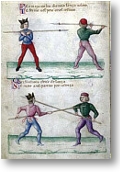 |

 |
Codex 1324, fondo Vittorio Emanuele della Biblioteca Nazionale di Roma - Vadi's manuscript appears to be of lineage to that of Fiore dei Liberi due to a number of similarities between Vadi's manuscript and Liberi's. Some differences are notable such as the variations in the nomenclature of strikes, e.g. upper-cuts fendente in Vadi to sotani in Liberi, and horizontal cuts volante in Vadi and mezana in Liberi. Other differences, not included in this online presentation is that Vadi's prologue is 28 pages compared to Liberi's 5 pages in the Getty's version.
- released August 10, 2001 |
|
 Hans von Speyer, 1491, "Handschrift M I 29 (Fechtbüch)" - Universitätsbibliothek Salzburg Hans von Speyer, 1491, "Handschrift M I 29 (Fechtbüch)" - Universitätsbibliothek Salzburg |
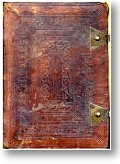 |
 |
Hans von Speyer Salzburg, Universitätsbibliothek - M.I.29 1491 - A text transcript of the Hans von Speyer fechtbüch, a compilation of lessons written down in 1491. This contains longsword, messer, short sword, wrestling, fencing on horse, and jousting with lance. Hans von Speyer was the scribe, the lessons are from various masters including Liechtenauer, Ott, Lew, Lecküchner, and Hundfelt.
- released June 6, 2003- Click on the "griffen arms" to see an English translation of Mag. Andreas' Messer-Longsword essay on plates 5r to 7r of this fechtbüch.
 | <== click icon to log into the library to access the manuscript by
Hans von Speyer |
|
|

 resources : online library : 15th Century Sources
resources : online library : 15th Century Sources



































 The AEMMA shield visible in some of the entries above indicates a resource that has restricted access to AEMMA internal only for research and study, and is not available for viewing in the public domain. This is due to the fact that permission to release the material into the public domain from the source was not granted.
The AEMMA shield visible in some of the entries above indicates a resource that has restricted access to AEMMA internal only for research and study, and is not available for viewing in the public domain. This is due to the fact that permission to release the material into the public domain from the source was not granted. Some of the online manuscripts have an audio component indicated by the speaker icon situated next to the country flag on the library listings.
Some of the online manuscripts have an audio component indicated by the speaker icon situated next to the country flag on the library listings.